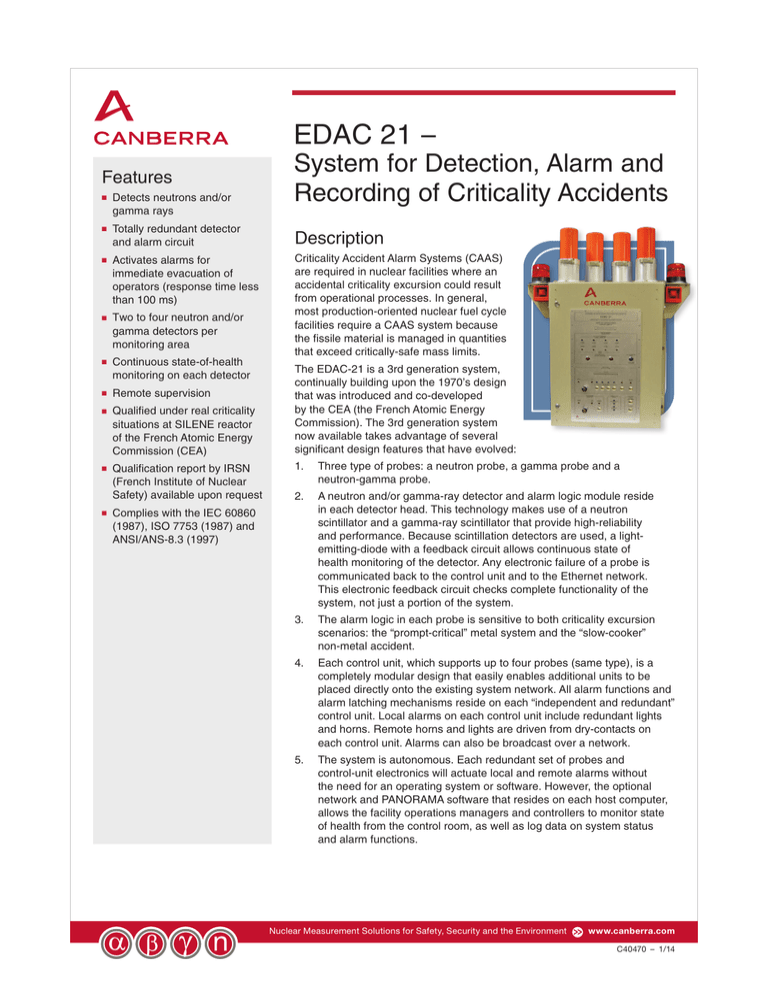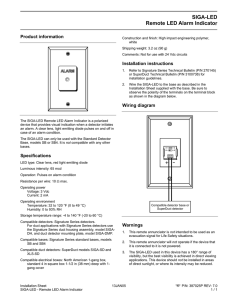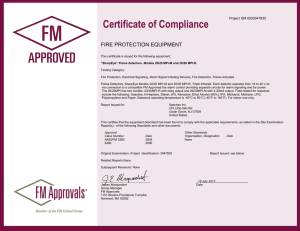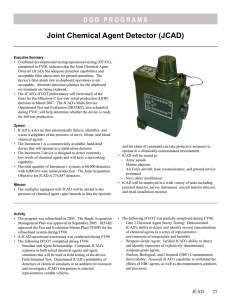
EDAC 21 –
Features
Detects neutrons and/or
gamma rays
■
System for Detection, Alarm and
Recording of Criticality Accidents
Totally redundant detector
and alarm circuit
Description
Activates alarms for
immediate evacuation of
operators (response time less
than 100 ms)
Criticality Accident Alarm Systems (CAAS)
are required in nuclear facilities where an
accidental criticality excursion could result
from operational processes. In general,
most production-oriented nuclear fuel cycle
facilities require a CAAS system because
the fissile material is managed in quantities
that exceed critically-safe mass limits.
■
■
Two to four neutron and/or
gamma detectors per
monitoring area
■
Continuous state-of-health
monitoring on each detector
■
Remote supervision
■
Qualified under real criticality
situations at SILENE reactor
of the French Atomic Energy
Commission (CEA)
■
Qualification report by IRSN
(French Institute of Nuclear
Safety) available upon request
■
Complies with the IEC 60860
(1987), ISO 7753 (1987) and
ANSI/ANS-8.3 (1997)
■
The EDAC-21 is a 3rd generation system,
continually building upon the 1970’s design
that was introduced and co-developed
by the CEA (the French Atomic Energy
Commission). The 3rd generation system
now available takes advantage of several
significant design features that have evolved:
1. Three type of probes: a neutron probe, a gamma probe and a
neutron-gamma probe.
2. A neutron and/or gamma-ray detector and alarm logic module reside
in each detector head. This technology makes use of a neutron
scintillator and a gamma-ray scintillator that provide high-reliability
and performance. Because scintillation detectors are used, a lightemitting-diode with a feedback circuit allows continuous state of
health monitoring of the detector. Any electronic failure of a probe is
communicated back to the control unit and to the Ethernet network.
This electronic feedback circuit checks complete functionality of the
system, not just a portion of the system.
3. The alarm logic in each probe is sensitive to both criticality excursion
scenarios: the “prompt-critical” metal system and the “slow-cooker”
non-metal accident.
4. Each control unit, which supports up to four probes (same type), is a
completely modular design that easily enables additional units to be
placed directly onto the existing system network. All alarm functions and
alarm latching mechanisms reside on each “independent and redundant”
control unit. Local alarms on each control unit include redundant lights
and horns. Remote horns and lights are driven from dry-contacts on
each control unit. Alarms can also be broadcast over a network.
5. The system is autonomous. Each redundant set of probes and
control-unit electronics will actuate local and remote alarms without
the need for an operating system or software. However, the optional
network and PANORAMA software that resides on each host computer,
allows the facility operations managers and controllers to monitor state
of health from the control room, as well as log data on system status
and alarm functions.
Nuclear Measurement Solutions for Safety, Security and the Environment www.canberra.com
C40470 – 1/14
EDAC 21 –
System for Detection, Alarm and Recording of Criticality Accidents
PCs with PANORAMA supervision software
Ethernet Hub
Hot
Cell
Power Supply Unit
EDAC 21 Control Unit
Specific capabilities of the system are provided below.
SYSTEM ARCHITECTURE
The EDAC 21 consists of different modules: Control unit,
probes and power supply unit.
Control Unit
■ The control unit contains a fully redundant set of
processing boards. Failure of any single board does
not cause a system failure. Board-level failures are
communicated with a local alert message to the
control unit and an Ethernet message communicated
over the network so that maintenance can be
performed.
■
■
■
■
Mounted to each control unit is a set of redundant
alarms: both horns and lights.
The probes may be mounted in the top of the control
unit or apart from the control unit, on a mounting
bracket.
The control unit connects to a DC power,
uninterruptible power supply (the power supply unit),
a dry contact output, and an RJ-45 connection to the
Ethernet network.
The control unit has a front panel display and controls
to indicate “state of health,” annunciate alarms, and
conduct tests and maintenance.
Probes
■ The neutron and gamma detectors use state of the art
scintillation plastic and signal-processing electronics.
■ The probes also contain in a single enclosure the
alarm logic boards, that upon alarm send alarm
messages to the control unit.
ALARM CAAS
Secondary Unit
Relay contact with power supply for
audible alarms and flashing lights
EDAC 21
System Overview
Power Supply Unit
■ Fully equipped power supply unit including redundant
power supplies ensures 16 hours of autonomous
operation in non-alarming mode plus 30 minutes in
alarming.
Optional Ethernet Panel
■ Network gear for providing a dedicated EDAC network
is designed and tailored to facility needs and security
requirements.
EDAC Software
■ The EDAC software is written on the PANORAMA
platform. When the network is implemented, each host
computer includes the PANORAMA software.
Alarm CAAS Secondary Unit
■ For a multi-area coverage
(two or more EDAC 21), an
alarming cabinet could be
built on customer request.
STATUS INDICATORS
Front panel access to indicators
and controls ensures local
control of detection devices
and alarm generators:
Probe indicators (LED):
■ 4 green “Correct Operation”
■ 4 red “Alert”
Processing unit indicators:
■ 2 red “Alarm” flashing beacons
■ 2 audible alarms
■ 2 redundant LED evacuation alarms
EDAC 21 –
System for Detection, Alarm and Recording of Criticality Accidents
EDAC 21 – Gamma and /or Neutron Probe
■
■
■
■
Individual or general tests of the detectors
(measurement displayed using bargraphs; these tests
are achieved under control of an operator who can
deactivate them in case of possible criticality accident.
Test of the cabinet indicator lights by pushbuttons.
Acknowledgment of faults and alarms (audible and
visual) by pushbuttons.
As an option, the system is associated with one or two
supervisor PCs on which the PANORAMA supervision
software is implemented; this software is in charge of
system monitoring, remote and real time archiving/
recording of the events, remote control of the detector
gain and edition of the logbook and detector test as
described above.
Real recording on SILENE reactor
2-probe version – Free evolution – Time scale: 1 hour.
Voltage is a function of time during SILENE testing for
EDAC 21. Unit accurately traces time profile for two probes
during free oscillation of SILENE reactor.
REMOTE SUPERVISION USING EXTERNAL PC
The graphic user interface makes it possible to know in
real or delayed time:
■ Data status for each detector (correct operation, alert,
measurement).
■ Real time display of the response from each detector.
■ History readings and events for each detector.
This information is shown on specific screens and is
password protected.
DETECTOR FEATURES
Monitoring of the plant and surrounding buildings is
ensured by a set of two, three or four detectors, each with:
■ Spectral response balanced in a simple/mixed flux
of referenced gamma and/or neutrons.
■ Two phase alarm signal:
Probe Detection
Dose (Gy)
Dose rate (Gy/h)
Gamma + Neutron
25 x 10-6
20 x 10-3
The probe dose-rate threshold can be modified in
a limited range without invalidating the response
qualifications. Consult factory for specific needs.
■ The detector response is linear between the dose
rates of 1 mGy/hr to 10 Gy/hr. Above 10 Gy/hr the
detector does not fail and continues to alarm.
■ Possibility of detecting accidents with extremely slow
dynamics corresponding to very low reactivities.
■ Constant state of health monitoring provided by light
source (LED), integrated into the detector.
■ The detector can be placed in a remote location and
connected by cable to the control unit (maximum
distance 300 m).
■
The graphical human interface: surveillance view of an EDAC unit
INFORMATION SUPPLIED BY THE SYSTEM
■ Detector response and status information for each
detector.
■ Comprehensive view of all significant events (alert,
alarm, fault, or test) with date/time stamp using the
log file maintained on the optional supervisor PC.
EDAC 21 –
System for Detection, Alarm and Recording of Criticality Accidents
■
■
Manual test of the cabinet using two buttons. The first
button checks the status of each detector, and the
second button checks the functionality of the alarm.
These operations may also be performed remotely on
the optional supervisor PC.
SYSTEM VALIDATION TEST
■ Before system delivery and installation, detectors are
calibrated for accurate responses.
■ Optionally, each system can be tested and validated
on the SILENE experimental equipment of CEA.
CHOICE OF Detector LOCATION
■ Optionally, an assessment can be carried out to
determine the best possible number and position
of the detectors to ensure reliable detection and
emergency functions (Please consult us).
Specifications
COMPLIANCE
■
Meets or exceeds the IEC 60860 (1987), ISO 7753
(1987), ANSI/ANS 8.3 (1997) standards.
REDUNDANCY
By parallelization of:
– processing circuitry
– alarm circuitry
– safety path from detector to alarm employs the
principal of redundancy for the whole system except
for detector logic which is 2-out-of-3 or 2-out-of-4
alarm logic
– communication and supervision circuitry
■ This configuration meets the criticality standards in case
of failure of part of the circuitry.
■
RELIABILITY
System remained fully operational under conditions of
a criticality excursion on three separate test reactors.
System was shown to have survived the criticality event
in each case.
■ The system is seismically qualified.
■
MAINTAINABILITY
■
“Hot swappable” design concept allows replacement
of processing and alarm circuitry components without
powering down the system.
POWER
LOW VOLTAGE POWER CABINET – To protect the
system against possible failure of the LVPS, lead-acid
batteries of the EDAC 21 ensure continuous power
supply in accordance with the specified standards.
■ LOW VOLTAGE POWER SUPPLY – 12 V.
■ MAINS – 110 -240 V ac/50/60 Hz.
■ BATTERY CAPACITY – 40 Ah each.
■ Batteries are doubled.
■
PHYSICAL
CONTROL UNIT
■ WIDTH – 940 mm (37.0 in.).
■ DEPTH – 360 mm (14.2 in.).
■ HEIGHT – 190 mm (46.9 in.) including detectors,
940 mm (37.0 in.) excluding detectors.
■ OPERATING TEMPERATURE (probes included) –
-10 °C (14 °F) to +45 °C (113 °F).
■ OPERATING HUMIDITY (probes included) – 40% to 90%.
■ MOUNTING – Wall mount.
■ MASS – 80 kg (176 lb) (detectors excluded).
PROBE
■ LENGTH – 510 mm (20.1 in.)
■ DIAMETER – 100 mm (3.9 in.).
■ MASS – 2.2 kg (4.8 lb).
■ MOUNTING – Integrated (extruding from top of Control
Unit) or remote (on mounting bracket).
POWER SUPPLY UNIT:
■ DIMENSIONS – 600 x 800 x 300 mm (23.6 x 31.5 x
11.8 in.) (W x H x D).
■ MASS – 125 kg (275 lb).
■ MOUNTING – Wall mount.
OPTIONS
Roller for transport of each cabinet.
Cable between gamma and/or neutron detector and
processing cabinet (max. length 1 km).
■ Choice of probe location: Optionally, an expertise can be
carried out to determine the best possible number and
position of the detectors to ensure reliable detection and
emergency functions (please consult us).
■ Each system can be tested and qualified on the SILENE
reactor.
■
■
SILENE
reactor
SUPERVISION
■
The graphic interface allows real time (or delayed time)
knowledge of:
– Data status for each detector
– History of the events
– Crisis communication (optional)
Processing cabinet
EDAC probes
EDAC probes
ALARM INDICATION
■
■
AUDIBLE – Two sirens.
VISUAL – Two flashing beacons and two LEDs.
Lead
shielding
Supply power cabinet
© 2014 Canberra Industries, Inc. All rights reserved.
Test of an EDAC probe on the SILENE criticality
facility (CEA facility).




